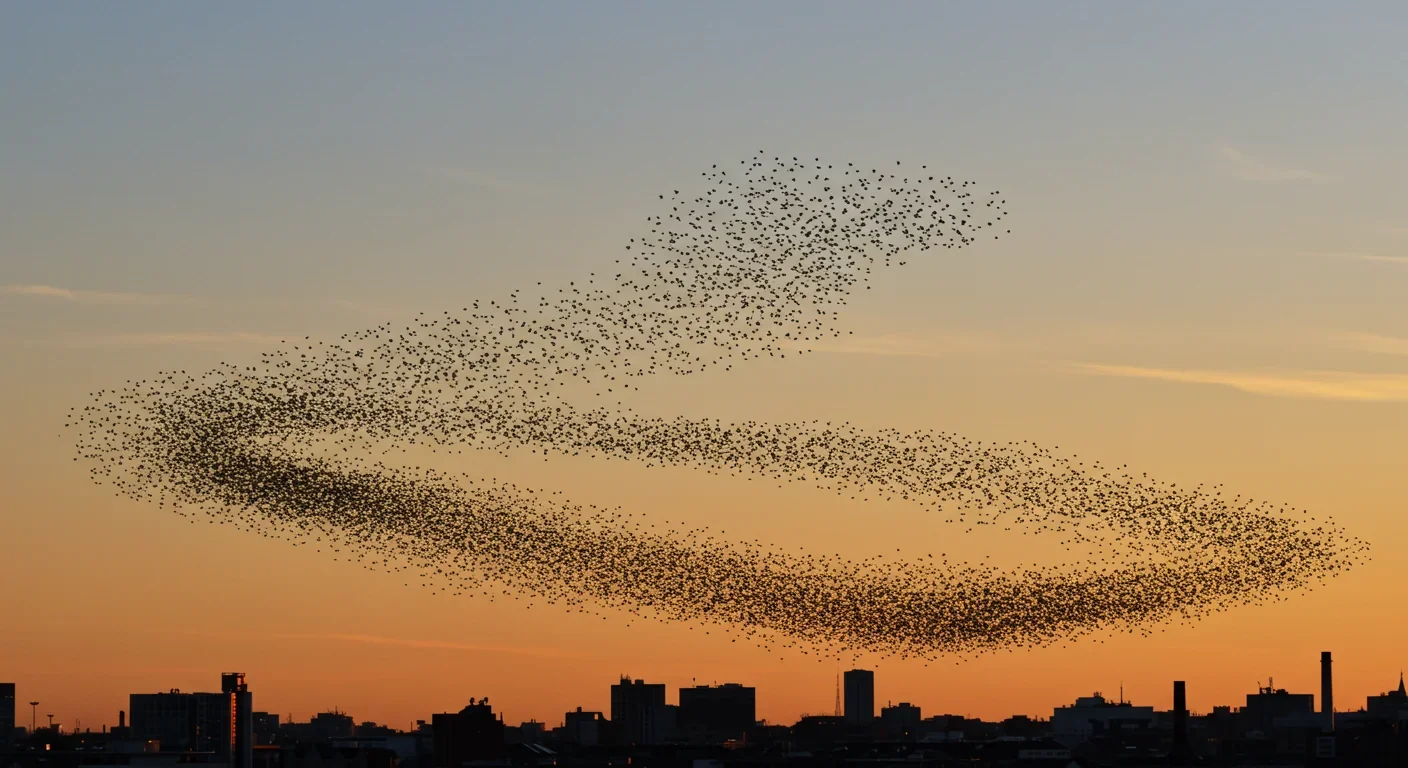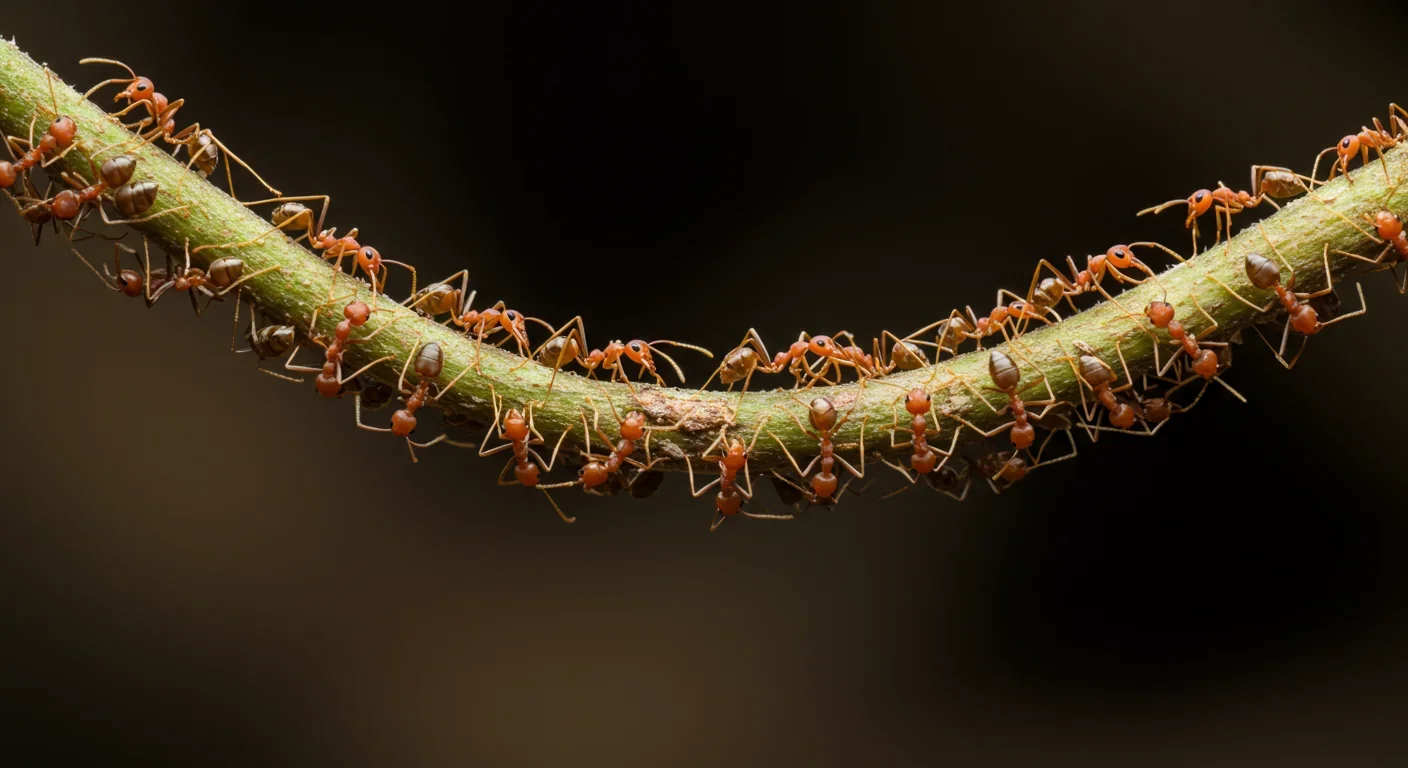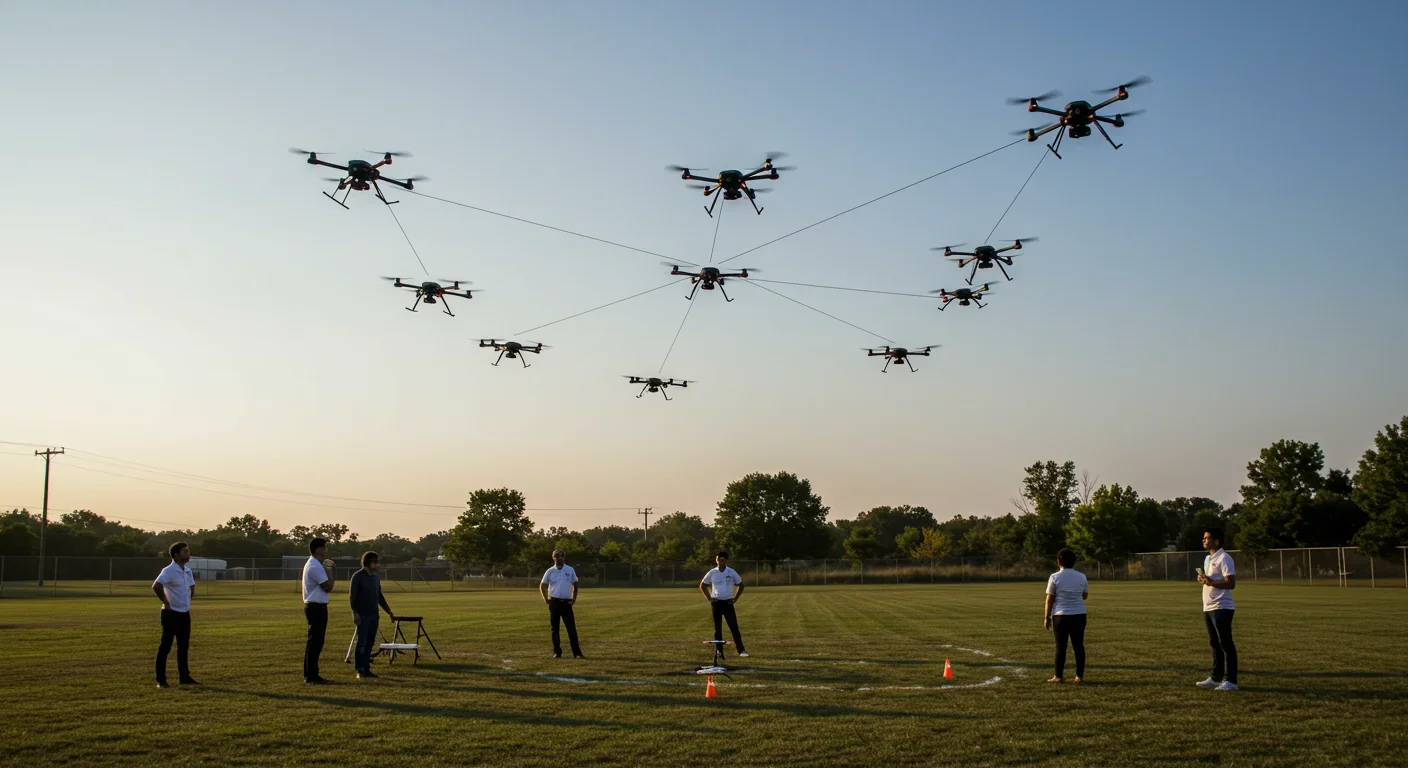Bombardier Beetle Chemical Defense: Nature's Micro Engine

TL;DR: Swarm intelligence proves that complexity emerges from simplicity. Nature's simplest creatures—ants, bees, birds—follow basic local rules to solve problems that baffle centralized systems, and engineers are now applying these principles to revolutionize robotics, logistics, and AI.

What if the next breakthrough in artificial intelligence doesn't come from training bigger neural networks, but from watching ants find food? Within the next decade, you'll likely see drone swarms delivering packages, self-driving cars coordinating at intersections, and AI systems solving problems that would baffle even the smartest centralized computer. All because researchers figured out how nature's simplest creatures produce the most complex solutions.
Swarm intelligence flips traditional thinking on its head. Instead of one brilliant leader orchestrating everything, thousands of agents follow a handful of dead-simple rules, and magic happens.
Take ants. Each one has a brain smaller than a pinhead. Yet colonies build intricate underground cities, find optimal routes to food sources, and allocate labor across tasks without a single ant understanding the big picture. How? Three basic rules:
Rule 1: Follow stronger pheromone trails.
Rule 2: Leave your own pheromone when carrying food.
Rule 3: Wander randomly when there's no trail.
That's it. No maps, no planning meetings, no strategic vision. Just local interactions repeated millions of times until the colony behaves like a superintelligent organism.
Researchers at Seoul National University recently used physics-informed AI to decode these local rules in flocking birds. They trained neural networks on GPS trajectories of real pigeons and discovered two fundamental interaction types: distance-based rules that maintain spacing, and velocity-based rules that align heading. These simple mechanisms, combined in different ways, generate every collective pattern we see, from V-formations to swirling murmurations.
The whole becomes other than the sum of its parts. That's not poetry but physics. Philip W. Anderson won a Nobel Prize partly for explaining why large systems require entirely new theories. You can't understand a flock by studying one bird, and you can't understand consciousness by mapping individual neurons. Emergence happens at the boundary between chaos and order, where simple rules collide with complex environments.
Before Silicon Valley existed, evolution ran the ultimate optimization lab. Every successful swarm in nature solves a problem worth studying.
Bees vote on new hive locations through a dance-off. Scout bees perform waggle dances with intensity proportional to how good a site is. Other scouts check out the advertised spots and add their own dances. The site that accumulates the most collective enthusiasm wins, producing decisions that are often better than any individual bee could make. It's democracy without politics, consensus without committees.
Fish schools use three zones of interaction. Too close? Move apart. Medium distance? Align with your neighbors. Far away? Move closer. These zones create the fluid, coordinated motion that confuses predators. A barracuda can't target one fish when hundreds move as a single, shape-shifting entity.
Bacteria communicate through chemical signals in a process called quorum sensing. Individual cells release molecules into their environment. When enough neighbors are present, the collective signal crosses a threshold and triggers coordinated behavior like forming biofilms or releasing toxins. It's how infections overwhelm immune systems and why your kitchen sponge smells after a week.
Even slime molds, which aren't really animals or even proper organisms, demonstrate remarkable problem-solving. Spread one across a maze with food at two points, and it will find the shortest path connecting them. No brain required, just cellular feedback loops.
What unites all these systems? No central controller. Local information only. Simple rules, repeated. And one more thing: they're robust. Lose 30% of a flock and it still flies. Squash half an ant colony and it rebuilds. Decentralization isn't just elegant, it's antifragile.
Translating ant behavior into algorithms started in the early 1990s with Ant Colony Optimization (ACO). Computer scientist Marco Dorigo asked: what if we simulate digital ants exploring solution spaces, leaving virtual pheromones on good paths?
ACO now solves routing problems that would take conventional methods years to crack. One recent study compared ACO against Google's OR-Tools on delivery routing in Greater Cairo. ACO found routes averaging 9 km versus the human technician's 27.8 km, a 67.6% improvement in distance and 11.55% cost reduction. The swarm algorithm didn't just beat human intuition; it crushed it.
But here's where things get interesting. While ACO found better routes, OR-Tools actually ran faster, solving 50-location problems in 4.4 seconds versus ACO's 42.6 seconds. At 100 locations, the gap widened: 9.6 seconds for OR-Tools, 308.1 seconds for ACO. So why use swarm methods at all?
Adaptability. OR-Tools requires recomputation when conditions change. ACO just keeps adjusting pheromone trails. A traffic jam blocks a route? The virtual ants automatically find alternatives. New delivery locations appear mid-shift? The swarm incorporates them without restarting. In static problems, centralized algorithms win. In dynamic, uncertain environments, swarms dominate.

Consider drone swarms. A team at MDPI developed inverse ant colony algorithms (IACA) for high-altitude UAV coverage. Instead of following pheromone trails, their drones avoid them, ensuring even area coverage without redundant overlaps. Combined with artificial potential fields that repel drones from high-pheromone zones, the system dramatically outperforms traditional coverage methods.
The breakthrough enables applications we couldn't attempt before: search-and-rescue operations across disaster zones, agricultural monitoring of vast farmlands, environmental sensing in remote areas. A dozen drones can survey more ground in an hour than a helicopter crew could in a week. And if three drones fail? The remaining nine adapt instantly.
The technology isn't coming; it's here.
Logistics and routing have been transformed by swarm algorithms at companies like Amazon and UPS. Route optimization that once required days of computation now happens in real-time. Package sorting facilities use robotic swarms coordinating without central control, each robot negotiating right-of-way with nearby units through simple priority rules. The result? 50% faster sorting with fewer collisions.
Disaster response increasingly relies on drone swarms. When Nepal's 2015 earthquake flattened villages, researchers proposed deploying swarms to map damage and locate survivors. Traditional reconnaissance would have taken weeks. A properly coordinated swarm could cover the same ground in days, feeding real-time data to rescue teams.
Network security uses artificial immune systems inspired by biological swarms. Your body doesn't have a "central virus detector." Instead, millions of white blood cells patrol independently, each recognizing threats through local pattern-matching. Computer scientists built digital versions that detect novel cyberattacks by mimicking this distributed surveillance.
Manufacturing adopted swarm principles in flexible production lines. Instead of rigid assembly sequences, stations negotiate task allocation based on current workload and part availability. It's manufacturing that breathes, adjusting to disruptions without stopping the line.
But the most striking example might be traffic management. What happens when self-driving cars coordinate at intersections? One vision involves vehicle swarms negotiating passage through "slot-based" intersection protocols. No traffic lights, no stop signs, just continuous flow as vehicles weave through gaps in perpendicular traffic. Simulations show this could triple intersection throughput while eliminating accidents.
Swarm intelligence isn't a silver bullet. Ask any researcher who's tried scaling a 10-agent simulation to 1,000 agents, and they'll tell you where the bodies are buried.
Scalability hits walls. Those ACO routing algorithms that work beautifully for 100 locations start choking at 1,000. The search space explodes exponentially. Comparative studies show particle swarm optimization (PSO) variants struggling with high-dimensional problems. Adding parallelization helps, but then you need cluster computing for problems you hoped to solve on a laptop.
Parameter tuning is black magic. ACO requires setting pheromone evaporation rates, influence weights, and exploration-exploitation balance. Get them wrong and your swarm either converges prematurely on mediocre solutions or wanders aimlessly forever. There's theory about optimal parameters, but it rarely survives contact with real-world messiness.
Verification and safety pose existential questions. How do you prove a drone swarm won't crash into civilians when its behavior emerges from millions of local interactions? Traditional software verification assumes you can trace every execution path. Swarm systems have more possible states than atoms in the universe. The FAA won't approve "it probably works" for urban airspace.
Adversarial robustness remains unsolved. What happens when someone injects false information into your swarm's communication? Ants can't hack each other's pheromones, but digital swarms are vulnerable. One compromised drone feeding bad data could cascade into catastrophic failure. Researchers are exploring secure communication protocols for UAV swarms, but we're in an arms race with attackers.
Emergent behavior sometimes surprises. The whole point of swarms is that collective behavior transcends individual programming. That's also the risk. In 2016, a trading algorithm swarm caused a flash crash that wiped billions from markets in seconds, then recovered before humans could react. Nobody programmed that outcome. It emerged.
Here's the dirty secret: most "swarm intelligence" systems are inspired by nature, not faithful copies. Ant Colony Optimization borrows the pheromone idea but uses it in abstract solution spaces that have nothing to do with physical trails.
That's actually fine. Biomimicry isn't about plagiarism; it's about principles. The question isn't "exactly how do ants do it?" but "what can ants teach us about decentralized optimization?"
Recent work on foundation models for artificial life suggests a different approach: instead of hand-crafting rules inspired by biology, use AI to discover rules that produce desired emergent behaviors. Train models on characteristics you want (coverage, coordination, efficiency) and let them generate the underlying interaction patterns.
One team implemented this for the classic Boids flocking simulation, which mimics bird swarming through three rules: separation, alignment, and cohesion. By varying parameters, they generated everything from tight flocks to dispersed swarms to chaotic turbulence. The simulations weren't perfectly realistic, but they produced the right qualitative behaviors for applications like crowd simulation in video games.

This suggests a future where we stop asking "how does nature do X?" and start asking "what rules produce useful emergent behavior for problem Y?" Biology provides the inspiration and proof of concept. Engineering takes it from there.
While Silicon Valley obsesses over large language models, other parts of the world are quietly building swarm infrastructure.
China leads in drone swarm deployment. Their military demonstrated 1,000-drone formations in 2021, and companies like EHang are testing passenger-carrying autonomous air taxis that coordinate as swarms. The strategy is clear: win the skies through coordinated autonomy, not individual superiority.
European researchers dominate theoretical foundations. The Swarmanoid project pioneered heterogeneous robot swarms (ground, air, and climbing bots) working together. EU funding prioritizes bio-inspired robotics, creating a pipeline from academic research to industrial application.
Japan focuses on disaster response swarms. Given their earthquake vulnerability, they're developing robotic systems that can navigate collapsed buildings and communicate in GPS-denied environments. The technology could save thousands of lives in the next major quake.
The United States concentrates on military applications. DARPA's OFFensive Swarm-Enabled Tactics program envisions 250-drone swarms overwhelming enemy defenses. Each drone is expendable, but the swarm is unstoppable. It's a radical shift from expensive, vulnerable manned aircraft.
India and Brazil are exploring swarm optimization for infrastructure challenges. Traffic management in Mumbai and São Paulo could benefit enormously from swarm-based coordination. Early trials show 30-40% reductions in average commute time through adaptive signal timing based on distributed traffic sensing.
The geopolitical dimension matters. Swarm technology democratizes capability. You don't need billion-dollar fighter jets when hundreds of $5,000 drones can achieve similar effects. That's threatening to established powers and empowering to everyone else.
So what should you learn if you want to work on swarm intelligence?
Mathematics: Differential equations, graph theory, and probability are non-negotiable. Swarm behavior involves continuous dynamics, network topology, and stochastic processes. You need the math to model, analyze, and predict.
Programming: Python dominates for prototyping and simulation. Learn NumPy, SciPy, and visualization libraries like Matplotlib. For real-time embedded systems, C++ remains essential. Increasingly, researchers use Julia for performance-critical scientific computing.
Domain knowledge: The best swarm applications come from people who understand the problem domain deeply. Traffic engineers who learn swarm algorithms beat computer scientists who know nothing about transportation. Subject matter expertise plus swarm thinking creates breakthroughs.
Systems thinking: Train yourself to see interactions, not just components. When analyzing a problem, ask: "What if there's no central controller? What local information could agents access? What simple rules might generate the desired global behavior?" It's a mental shift from top-down to bottom-up design.
Experimentation mindset: Swarm systems are notoriously hard to predict analytically. You need to simulate, test, and iterate. Get comfortable with uncertainty and emergent surprises. Build intuition through play.
The good news? Barriers to entry keep dropping. Open-source swarm simulation frameworks like NetLogo and MASON let you prototype ideas in hours. Online courses cover the fundamentals. The field welcomes newcomers because fresh perspectives often crack problems that stumped experts.
Five years from now, swarm technology will be unremarkable. Package delivery drones coordinating autonomously. Cars negotiating intersections without signals. Warehouse robots dancing around each other in apparently choreographed chaos.
The deeper transformation comes when we stop thinking about swarms as a technique and start seeing them as a paradigm. Just as object-oriented programming changed how we structure software, swarm thinking will change how we approach any system with multiple interacting agents.
Hybrid approaches combining swarm exploration with centralized optimization are emerging. Why choose between ACO's adaptability and OR-Tools' speed? Use swarms to explore solution spaces and identify promising regions, then deploy powerful local search to refine those solutions. Early results suggest these hybrids might beat either method alone.
Learning swarms that improve through experience represent the next frontier. Today's swarm algorithms are mostly static (fixed rules, unchanging parameters). Tomorrow's will adapt their interaction rules based on outcomes. Imagine delivery drones that collectively learn traffic patterns and adjust routing heuristics automatically.
Swarm-human teams where people and autonomous agents collaborate through swarm interfaces could revolutionize everything from architecture to strategy. Instead of commanding robots individually, you shape the rules and watch solutions emerge. It's management by incentive design, not micromanagement.
The biggest open question isn't technical; it's philosophical. As swarms become more capable and autonomous, who's responsible when things go wrong? If a drone swarm makes an emergent decision that harms someone, is it the programmer's fault for writing the local rules? The operator's for deploying them? The manufacturer's for selling them? Society hasn't figured this out yet, and we probably should before swarms run critical infrastructure.
Here's what keeps me fascinated about swarm intelligence: it's proof that complexity doesn't require complexity. The most sophisticated behaviors can emerge from the simplest rules. Ants with pinhead brains build cities. Starlings with bird brains create sky-filling murmurations. Bacteria without brains at all coordinate chemical warfare.
What we're really doing with swarm intelligence isn't inventing something new. We're learning to read a language that nature has been writing for billions of years. Every successful species that survives through collective action is a theorem about coordination, a proof of concept for decentralized intelligence.
The question isn't whether swarm thinking will transform technology. It already has. The question is whether we'll be wise enough to deploy it responsibly, creative enough to imagine new applications, and humble enough to keep learning from the ants.
Because if a creature with a brain smaller than the period at the end of this sentence can teach us how to solve problems we thought required superintelligence, imagine what we haven't learned yet.

Recent breakthroughs in fusion technology—including 351,000-gauss magnetic fields, AI-driven plasma diagnostics, and net energy gain at the National Ignition Facility—are transforming fusion propulsion from science fiction to engineering frontier. Scientists now have a realistic pathway to accelerate spacecraft to 10% of light speed, enabling a 43-year journey to Alpha Centauri. While challenges remain in miniaturization, neutron management, and sustained operation, the physics barriers have ...

Epigenetic clocks measure DNA methylation patterns to calculate biological age, which predicts disease risk up to 30 years before symptoms appear. Landmark studies show that accelerated epigenetic aging forecasts cardiovascular disease, diabetes, and neurodegeneration with remarkable accuracy. Lifestyle interventions—Mediterranean diet, structured exercise, quality sleep, stress management—can measurably reverse biological aging, reducing epigenetic age by 1-2 years within months. Commercial ...

Data centers consumed 415 terawatt-hours of electricity in 2024 and will nearly double that by 2030, driven by AI's insatiable energy appetite. Despite tech giants' renewable pledges, actual emissions are up to 662% higher than reported due to accounting loopholes. A digital pollution tax—similar to Europe's carbon border tariff—could finally force the industry to invest in efficiency technologies like liquid cooling, waste heat recovery, and time-matched renewable power, transforming volunta...

Humans are hardwired to see invisible agents—gods, ghosts, conspiracies—thanks to the Hyperactive Agency Detection Device (HADD), an evolutionary survival mechanism that favored false alarms over fatal misses. This cognitive bias, rooted in brain regions like the temporoparietal junction and medial prefrontal cortex, generates religious beliefs, animistic worldviews, and conspiracy theories across all cultures. Understanding HADD doesn't eliminate belief, but it helps us recognize when our pa...

The bombardier beetle has perfected a chemical defense system that human engineers are still trying to replicate: a two-chamber micro-combustion engine that mixes hydroquinone and hydrogen peroxide to create explosive 100°C sprays at up to 500 pulses per second, aimed with 270-degree precision. This tiny insect's biochemical marvel is inspiring revolutionary technologies in aerospace propulsion, pharmaceutical delivery, and fire suppression. By 2030, beetle-inspired systems could position sat...

The U.S. faces a catastrophic care worker shortage driven by poverty-level wages, overwhelming burnout, and systemic undervaluation. With 99% of nursing homes hiring and 9.7 million openings projected by 2034, the crisis threatens patient safety, family stability, and economic productivity. Evidence-based solutions—wage reforms, streamlined training, technology integration, and policy enforcement—exist and work, but require sustained political will and cultural recognition that caregiving is ...

Every major AI model was trained on copyrighted text scraped without permission, triggering billion-dollar lawsuits and forcing a reckoning between innovation and creator rights. The future depends on finding balance between transformative AI development and fair compensation for the people whose work fuels it.